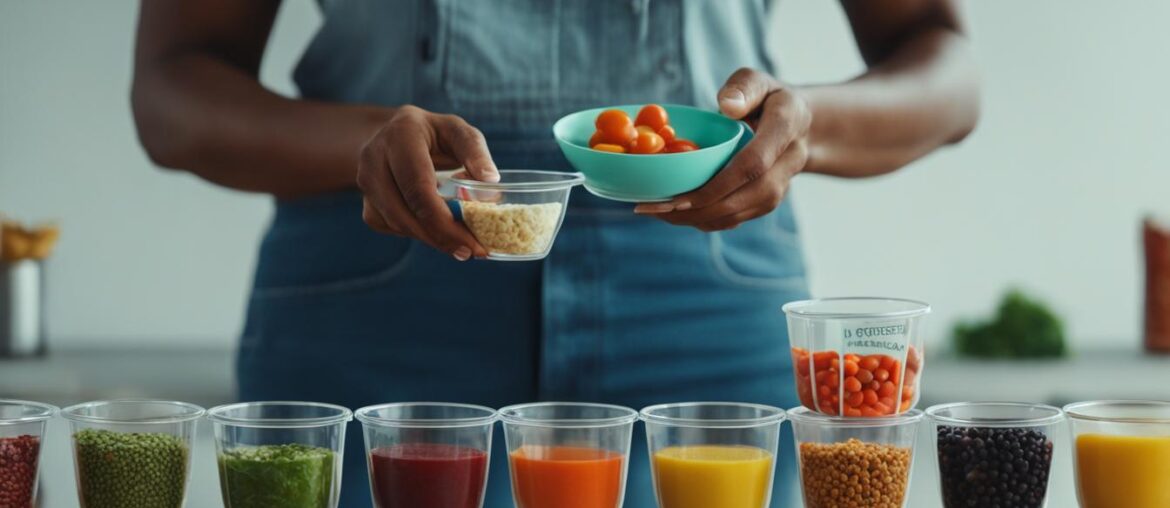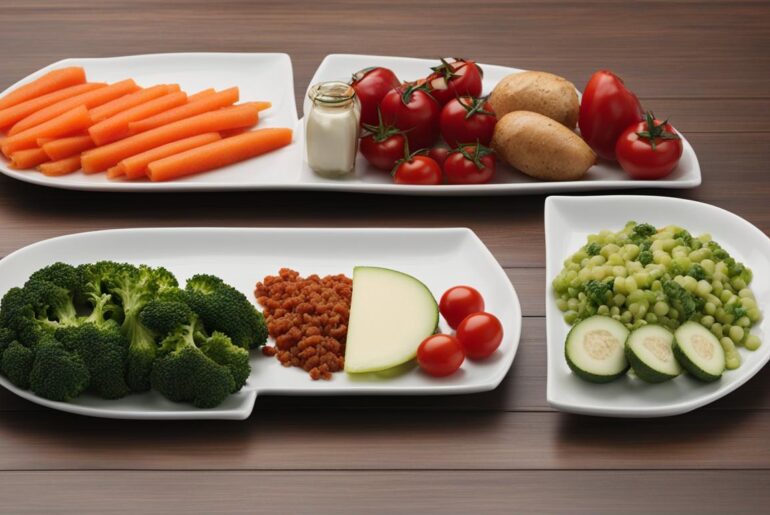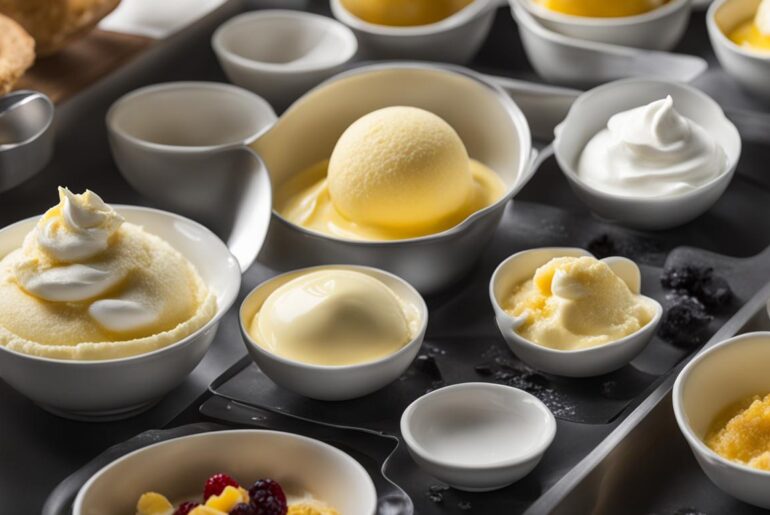Portion control is an essential aspect of maintaining a healthy diet and managing weight. With oversized portions becoming a common trend, it’s vital to find effective strategies to control our portion sizes. One practical and straightforward method is to incorporate measuring cups into our meal preparation. By using standard measuring cups, we can accurately measure the right amount of food and avoid overeating. This simple tool allows us to portion our meals properly, supporting our weight loss goals.
Measuring cups serve as a reliable guide to ensure accurate portion sizes (check out my post on accurate portion sizes here). They provide a visual representation of the recommended measurements, helping us control our food intake. With the right knowledge and tools, we can easily incorporate portion control into our daily routine, leading to a healthier lifestyle.
Key Takeaways:
- Using measuring cups is a practical strategy for portion control.
- Measuring cups help ensure accurate portion sizes, avoiding overeating.
- Incorporating portion control into our routine supports weight loss goals.
- Portion control with measuring cups promotes a healthier lifestyle.
- Measuring cups serve as visual guides for proper food portioning.
Use Smaller Plates and Bowls
https://www.youtube.com/watch?v=yyB5X062aRU
When it comes to portion control, sometimes it’s all about tricking the mind. One effective hack is to use smaller plates and bowls. By downsizing our dinnerware, we can create the illusion of a more substantial meal, even with smaller portions. Our brains are wired to perceive visual cues, and by filling up a smaller plate, we feel more satisfied without feeling deprived.
Whether you opt for specially designed portion control plates or simply use any smaller plate or bowl you have at home, the results can be equally effective (check out my post on portion control plates here). The key is to create the perception of a full plate while still managing your meal sizes. This portion control strategy is a simple adjustment that can go a long way in supporting your weight management goals (check this post out).
Here’s an example of how using smaller plates and bowls can make a difference:
| Plate/Bowl Size | Portion Size | Perceived Satisfaction |
|---|---|---|
| Large Plate/Bowl | 12 ounces | Minimal |
| Small Plate/Bowl | 8 ounces | Satisfying |
As you can see, using a smaller plate or bowl can make a noticeable difference in how satisfied you feel with your portion sizes. It’s a simple portion control strategy that can help you manage your meal sizes more effectively.
Remember, portion control is about finding strategies that work best for you. By incorporating the use of smaller plates and bowls into your meal routine, you can create a visual trick that keeps your satisfaction levels high while still managing your portions. Give it a try and see how it positively impacts your weight management efforts.
Measure Serving Sizes
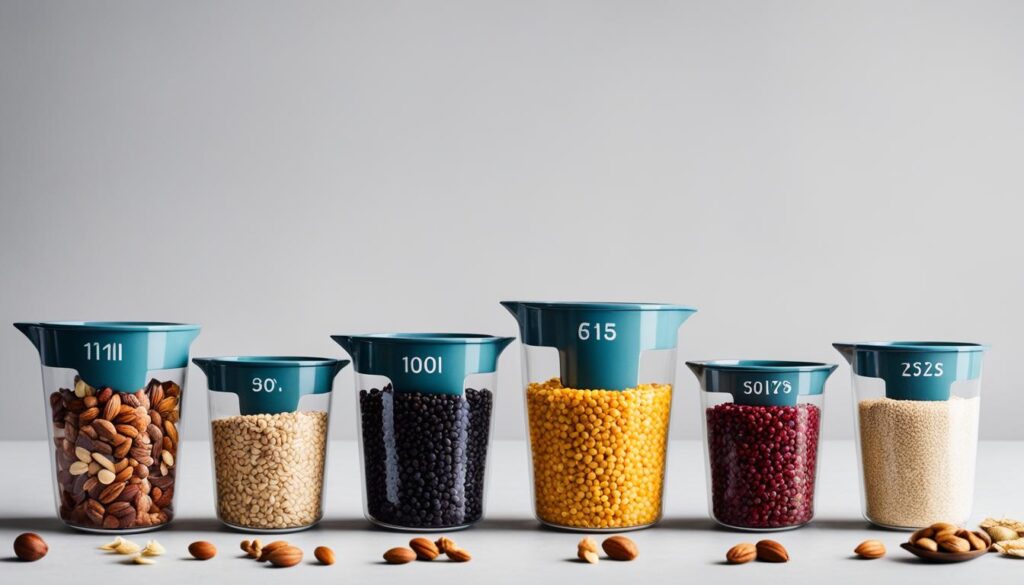
Accurately measuring serving sizes is crucial for effective portion control. Many times, we tend to underestimate the amount of food we consume, leading to overeating and hindering our weight loss efforts. To avoid this, it is essential to utilize measuring cups, spoons, or a food scale to determine the appropriate serving sizes for different types of food.
By measuring our portions accurately, we gain better control over our food intake and can make informed choices about the quantity of food we consume. This enables us to manage our calorie consumption effectively and support our weight loss goals.
An important aspect of portion control is educating ourselves about recommended serving sizes for different food groups. Understanding these guidelines helps us create a well-balanced diet and ensures that we are providing our bodies with adequate nutrition without overindulging.
Benefits of Using Measuring Cups for Portion Control
Using measuring cups specifically designed for portion control offers several advantages:
- Precision: Measuring cups provide accurate measurements, allowing us to portion our meals and snacks precisely.
- Consistency: By consistently measuring our portions, we develop a better understanding of appropriate serving sizes and make portion control a habit.
- Awareness: Measuring cups create awareness about our food choices and help us distinguish between the recommended portion and potentially excessive servings.
| Food Group | Recommended Serving Size |
|---|---|
| Grains (e.g., rice, pasta) | 1/2 cup cooked |
| Proteins (e.g., chicken, fish) | 3 ounces (the size of a deck of cards) |
| Fruits | 1 medium-sized fruit or 1/2 cup sliced fruit |
| Vegetables (raw or cooked) | 1 cup |
| Dairy (e.g., milk, yogurt) | 1 cup |
By being mindful of our portions and relying on measuring cups, we can easily adhere to these recommended serving sizes and maintain control over our food consumption.
Using measuring cups for portion control is a practical and effective technique that empowers us to make informed choices about the food we eat. With accurate portion measurements, we can successfully manage our calorie intake, support our weight loss efforts, and maintain a healthy lifestyle.
Pre-Portion Snacks
When it comes to portion control, pre-portioning our snacks can be a game-changer. Instead of mindlessly snacking from a large bag or container, we can take control of our portions by dividing our snacks into smaller bags or containers. This simple strategy not only prevents us from overeating but also promotes mindful snacking.
By pre-measuring our snacks, we create a visual reminder of the right amount we should be consuming. It helps us avoid the temptation to consume more than what our body actually needs. One effective tool for pre-portioning snacks is using measuring cups. They provide a precise and consistent measure, ensuring that we are eating the right amount each time.
Let’s take a look at some popular snacks and their recommended portion sizes:
| Snack | Recommended Portion Size |
|---|---|
| Almonds | 23 nuts (1 ounce) |
| Pretzels | 1 ounce (about 12 pretzels) |
| Popcorn | 3 cups |
| Grapes | 1 cup |
| Carrot Sticks | 10 sticks |
By portioning our snacks ahead of time, we make it easier to stick to our weight loss goals and avoid mindless munching. It’s a simple yet powerful strategy that can support our journey towards healthier eating habits.
Practice the “Plate Method”
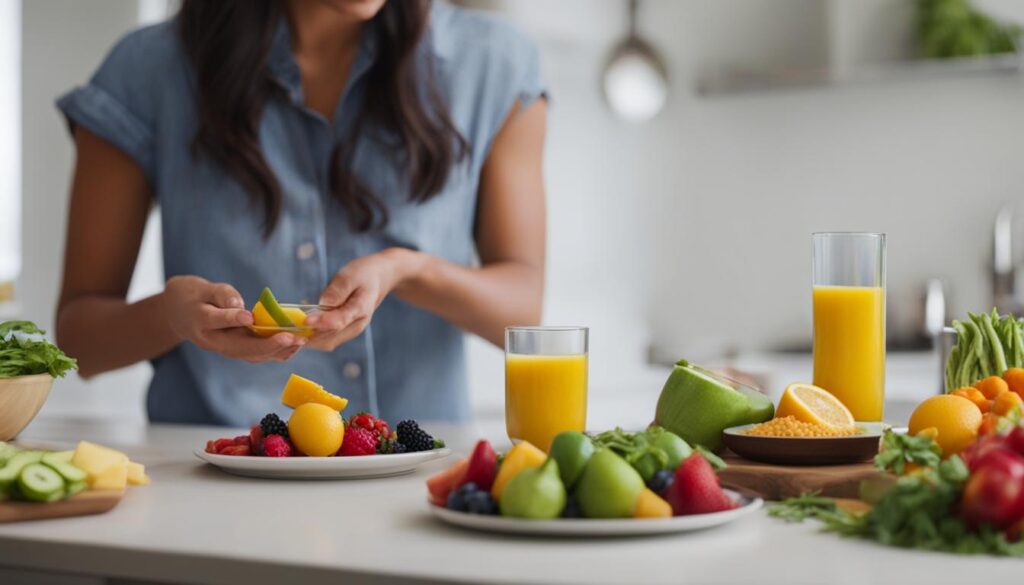
The “Plate Method” is a simple yet effective strategy for portion control. By dividing our plate into sections, we can visualize the right balance of macronutrients and control our portions. The recommended breakdown is filling half the plate with vegetables, one-quarter with lean protein, and the remaining quarter with whole grains or starchy vegetables. Using measuring cups for portion control can help us accurately measure and portion the right amount of each food group. By practicing the “Plate Method,” we can ensure a well-balanced meal and support our weight management goals.
Implementing the “Plate Method” helps us make conscious portion control decisions by visually dividing our plate into sections. This technique ensures that we incorporate an appropriate amount of different food groups in our meals. Let’s take a closer look at how the “Plate Method” can guide us towards better portion control:
1. Vegetables
Filling half of our plate with vegetables allows us to include nutrient-dense and low-calorie foods in our meals. Aim for a colorful variety of vegetables such as leafy greens, cruciferous vegetables, peppers, and carrots. Measuring cups can help us serve the recommended portion size and avoid overeating.
2. Lean Protein
Allocating one-quarter of our plate to lean protein sources like chicken breast, fish, tofu, or beans provides us with essential amino acids and helps build and repair tissue. Measuring cups can assist in serving the right amount of protein and prevent excessive intake.
3. Whole Grains or Starchy Vegetables
The remaining quarter of our plate can be dedicated to whole grains like quinoa, brown rice, or starchy vegetables such as sweet potatoes or corn. These carbohydrate sources provide energy and dietary fiber. Measuring cups help us control portion sizes and avoid overindulging in these foods.
By using measuring cups for portion control, we can ensure that we’re consuming appropriate amounts from each food group, which supports a well-rounded and balanced diet. With the “Plate Method,” we have a visual guide that simplifies portion control and helps us make healthier choices. Let’s take a look at a sample plate using the “Plate Method”:
| Plate Section | Food Group | Portion Size |
|---|---|---|
| Half | Vegetables | 1 cup |
| One-Quarter | Lean Protein | 3 ounces |
| One-Quarter | Whole Grains/Starchy Vegetables | ½ cup |
Creating a well-balanced plate with the help of measuring cups can ensure that we’re consuming appropriate portions of each food group. This approach supports portion control, allows us to enjoy a variety of foods, and helps us meet our weight management goals.
Be Mindful and Slow Down
When it comes to portion control, being mindful and slowing down while eating can make a significant difference. Many of us are guilty of rushing through our meals, not taking the time to truly savor and appreciate the food we’re consuming. However, this fast-paced eating habit can lead to overeating and a lack of awareness of our body’s hunger and fullness cues.
By taking the time to be present and fully engaged in our meals, we can naturally control our portion sizes and support our weight loss efforts. Here are some strategies to help you slow down and be more mindful during meal times:
- Chew slowly: Instead of mindlessly swallowing our food, make a conscious effort to chew each bite thoroughly. This not only aids digestion but also allows our brain to register the act of eating and the satisfaction it brings.
- Savor each bite: Take the time to truly taste and appreciate the flavors, textures, and aromas of the food you’re eating. This can enhance the sensory experience of the meal and promote a sense of satisfaction with smaller portions.
- Listen to your body: Pay attention to your body’s hunger and fullness cues. Eat until you feel comfortably satisfied, but not overly full. This requires tuning in and being aware of how your body feels throughout the meal.
Another helpful trick to promote mindful eating and portion control is to use flatware with smaller spoon or fork heads. This encourages smaller bites and forces us to eat more slowly, allowing our brain to catch up with our stomach’s signals of fullness.
By incorporating these practices into our meals, we can cultivate a mindful eating habit that supports portion control and aids in our weight loss efforts.
Benefits of Mindful Eating
| Benefits | Description |
|---|---|
| Increased satisfaction | Mindful eating helps us appreciate and enjoy our food, leading to greater satisfaction with smaller portions. |
| Better digestion | Taking the time to chew and properly digest our food can improve digestion and nutrient absorption. |
| Heightened awareness | Mindfulness during meals enhances our awareness of hunger and fullness cues, preventing overeating. |
| Reduced stress | Focusing on the present moment while eating can promote relaxation and reduce stress-related eating. |
| Enhanced flavor appreciation | By savoring each bite, we can fully experience and enjoy the flavors of the food we’re eating. |
Conclusion
Mastering portion control with measuring cups is a practical and effective technique for managing meal sizes and achieving weight loss goals (check out my post on managing meal sizes here). By incorporating various strategies such as using smaller plates and bowls, measuring serving sizes accurately, pre-portioning snacks, practicing the “Plate Method,” and being mindful and slow while eating, we can successfully control our portions and support a healthy lifestyle.
Implementing these portion control tips and techniques into our daily routine can contribute to maintaining a healthy weight and overall well-being (check this post out). Using measuring cups for portion control ensures precision and accuracy, allowing us to measure the right amount of food and avoid overeating. By making portion control a priority and combining it with a balanced diet and regular exercise, we can create long-term habits that lead to lasting success.
Remember, portion control is not about deprivation or restrictive diets; it is about understanding and managing the amount of food we consume. By practicing portion control with measuring cups, we can enjoy our favorite meals while still achieving our weight loss goals. Take control of your portions, focus on nourishing your body, and embrace a healthier lifestyle.

